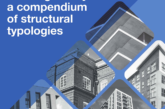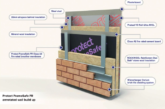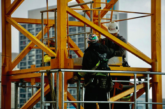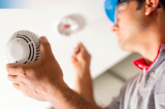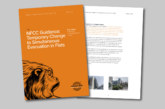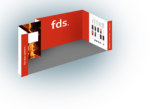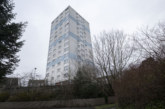Dave Walker, Technical Director of Distinction Doors, stockist and distributor of the fds (fire door systems), discusses the importance of effective fire door maintenance programmes and the Smoke Control Update, which in 2022 will require certification for doorsets to include smoke control.
Fire safety is probably the biggest housing maintenance and management concern for Registered Providers. Earlier this year it was reported that London’s biggest housing associations expect to spend almost £3bn over the next decade making safe those buildings with dangerous cladding.
The G15, a collective of London’s 12 biggest social landlords which own and manage over 600,000 homes, estimate a spend of £2.9bn on fire remediation. This will cover the cost of removing and replacing the cladding, insulation and cavity barriers on buildings taller than 18 metres.
While these figures now form part of a financial plan the knock-on for planned maintenance in existing and new-build social housing stock is significant.
Peter Benz, Director of Finance at Network Homes, says: “The effect of introducing this into our medium-term financial plan is substantial. It means we have fewer resources available to invest in our existing stock.
“We have recast our planned maintenance programme to ensure that sufficient resources are available to maintain our homes at a decent standard, but it has had the consequence of deferring some planned maintenance work and displaced some discretionary work.” (source: socialhousing.co.uk)
This is a concern. Nowhere more so than the maintenance of other fire safety products, for example entrance fire doors, in other landlords this may extend to fire door replacement etc. Network Homes, and the rest of the G15, take fire safety seriously and all monitor FRA actions through their governance structures.
Due to some performance issues identified post-Grenfell, it is understood that like cladding, insulation and cavity barriers, many fire entrance doors in high-rise buildings will also need replacing, at vast expense.
With housing maintenance and management departments facing serious financial constraints it is more important than ever that only tried, tested and proven fire safety products are procured and installed correctly across all housing stock.

Trusted testing
Fire doorsets, for example, should be third party tested and certificated using an independent United Kingdom Accreditation Service (UKAS) accredited test house. Proof of independent third-party testing offers reassurance to all stakeholders, demonstrating that the product has been verified by an expert and is publicly available.
One Glass Reinforced Polyester (GRP) composite fire door system supplier has raised the bar, satisfying not just the British Standard (BS 476-22) but also the more demanding European test method standard(BS EN 1634-1). The tests were conducted in three countries, using three variations of supporting wall construction — 150mm and 225mm rigid aerated block and flexible steel stud construction.
Proven performance
While fire protection is the key factor in the specification of a fire entrance doorset, it must also deliver against smoke control, security, weather, sound insulation and thermal performance. In addition to fire test evidence, procurement teams must also seek assurance for Ambient Smoke Control (EN1634-3:2004), Enhanced Security (PAS24:2016), Weather Performance (BS 6375), Thermal Performance (Approved Document L) and Secured by Design (SBD) accreditation.
Smoke Control Update (SBD)
It is worth highlighting that effective from 1st June 2022, SBD ‘…will require all SBD member companies with doorsets listed with us that are fire rated and that are required by UK Building Regulations (England, Scotland, Wales and Northern Ireland) to have smoke control properties for the intended installation e.g., flat entrance doorset, to be certificated for the following attributes — Security, Fire and Smoke Control.’ (source link: https://www.securedbydesign.com/about-us/news/certification-of-doorsets-to-include-smoke-control)
This change follows an internal review and extensive consultation after which SBD announced that it ‘…now understand[s] more clearly the importance of asphyxiation caused by smoke inhalation and that being the most common cause of deaths in flats when a fire occurs.’
SBD has declared that in its opinion guidance for doorset threshold testing is unacceptable in the real world — both the taping up method (BS 476-31.1 or BS EN 1634-3) and 3mm gap at the threshold in situations where fitting a threshold seal is not practicable (BS 8214). Both can lead to smoke leakage, with the latter proven to allow smoke leakage three times that of the allowance in current Building Regulations.

Certified installation
Some installation companies have recognised a demand for third party certification and have taken steps to achieve this. The BM TRADA Q-Mark Fire Door Installation scheme has been ‘…designed to provide reassurance to specifiers, contractors and end users that the product they have chosen has been installed correctly and that it should perform as intended.’
Purchasing departments and building maintenance and facilities managers would do well to seek fire door installation companies that meet the requirements of Q-Mark STD 052 and demonstrate competence in the installation of fire doors. This can sometimes be the same supplier that fabricates the fire door — in reality there is no one more competent.
With the procurement and accurate installation of appropriate fire safety products, we are one step closer to a safer future. Even in the grip of financial restrictions however, Registered Providers cannot afford to forgo maintenance of these products.
Long-term, maintenance is a crucial factor in the reliable and consistent performance of a fire door, for example. As a risk to life product, it is a duty of care. A robust maintenance and auditing schedule is essential as are regular inspections if we are to avoid another tragedy like Grenfell. Of course, every entrance fire door is as important as the next but, due to the volume of people and high footfall, this is particularly important in multi-occupied residential buildings.
An effective fire door maintenance programme is fundamental, one that addresses accountability and provides transparency. This must transcend party politics and financial constraints; the supply chain, housing providers and government owe it to the British public.


